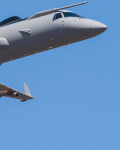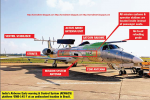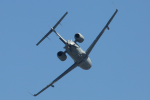Airborne Early Warning Systems - A-50EI Phalcon, DRDO Netra AEW&C, DRDO AWACS
- Thread starter Ashwin
- Start date
CAG Blows Holes In DRDO’s Early Warning Planes
After a Central Bureau of Investigation probe into corruption allegations, the Comptroller and Auditor General has also cast a shadow on an indigenous program for Airborne Early Warning and Control (AEW&C) system ordered by the Air Force.
In a detailed report, the CAG has stated that the project is yet to be fully realised even though it was conceived in 2002, leaving gaps in the IAF’s air-surveillance capability.
The auditor has said that operational requirements specified by the IAF were not met and added that there has been a 70% time overrun.
The central auditor also said selecting the Embraer aircraft as the platform created design constraints and caused the delays. It may be recalled that the CBI is probing allegations that kickbacks were paid in the Embraer aircraft deal that DRDO had struck with the Brazilian aircraft manufacturer in 2008.
The AEW&C is an airborne surveillance system which detects incoming hostile fighters, cruise missiles and drones much before ground based radars.
It also detects enemy troops build-ups, warships and directs friendly fighter jets during combat. The project for the indigenous development of the AEW&C of the IAF was approved by the Cabinet Committee on Security in October 2004 at a cost of `1,800 cr. The CAG, however, said that the project’s total cost up till August 2017 was `2,425 crore.
Under the project, two AEW&C were to be supplied to the IAF. The Bangalore based Centre of Air Borne Systems (CABS) of the DRDO was the nodal agency for developing the system.
The CAG says that the IAF had accepted the first AEW&C in February 2017. “However, out of the 18 operational requirements specified by the IAF, eight parameters could not be fully achieved by the AEW&C,” said the CAG report.
Some of these operational requirements are the primary surveillance radar for scanning the airspace to detect targets, the secondary radar to identify friends and foes, and the self protection suite to warn about incoming weapons. The IAF insisted that the eight parameters should be met in the second aircraft. The DRDO agreed to meet five of them, while arguing that the remaining three would not impact operations.
After a Central Bureau of Investigation probe into corruption allegations, the Comptroller and Auditor General has also cast a shadow on an indigenous program for Airborne Early Warning and Control (AEW&C) system ordered by the Air Force.
In a detailed report, the CAG has stated that the project is yet to be fully realised even though it was conceived in 2002, leaving gaps in the IAF’s air-surveillance capability.
The auditor has said that operational requirements specified by the IAF were not met and added that there has been a 70% time overrun.
The central auditor also said selecting the Embraer aircraft as the platform created design constraints and caused the delays. It may be recalled that the CBI is probing allegations that kickbacks were paid in the Embraer aircraft deal that DRDO had struck with the Brazilian aircraft manufacturer in 2008.
The AEW&C is an airborne surveillance system which detects incoming hostile fighters, cruise missiles and drones much before ground based radars.
It also detects enemy troops build-ups, warships and directs friendly fighter jets during combat. The project for the indigenous development of the AEW&C of the IAF was approved by the Cabinet Committee on Security in October 2004 at a cost of `1,800 cr. The CAG, however, said that the project’s total cost up till August 2017 was `2,425 crore.
Under the project, two AEW&C were to be supplied to the IAF. The Bangalore based Centre of Air Borne Systems (CABS) of the DRDO was the nodal agency for developing the system.
The CAG says that the IAF had accepted the first AEW&C in February 2017. “However, out of the 18 operational requirements specified by the IAF, eight parameters could not be fully achieved by the AEW&C,” said the CAG report.
Some of these operational requirements are the primary surveillance radar for scanning the airspace to detect targets, the secondary radar to identify friends and foes, and the self protection suite to warn about incoming weapons. The IAF insisted that the eight parameters should be met in the second aircraft. The DRDO agreed to meet five of them, while arguing that the remaining three would not impact operations.
CAG Blows Holes In DRDO’s Early Warning Planes
After a Central Bureau of Investigation probe into corruption allegations, the Comptroller and Auditor General has also cast a shadow on an indigenous program for Airborne Early Warning and Control (AEW&C) system ordered by the Air Force.
In a detailed report, the CAG has stated that the project is yet to be fully realised even though it was conceived in 2002, leaving gaps in the IAF’s air-surveillance capability.
The auditor has said that operational requirements specified by the IAF were not met and added that there has been a 70% time overrun.
The central auditor also said selecting the Embraer aircraft as the platform created design constraints and caused the delays. It may be recalled that the CBI is probing allegations that kickbacks were paid in the Embraer aircraft deal that DRDO had struck with the Brazilian aircraft manufacturer in 2008.
The AEW&C is an airborne surveillance system which detects incoming hostile fighters, cruise missiles and drones much before ground based radars.
It also detects enemy troops build-ups, warships and directs friendly fighter jets during combat. The project for the indigenous development of the AEW&C of the IAF was approved by the Cabinet Committee on Security in October 2004 at a cost of `1,800 cr. The CAG, however, said that the project’s total cost up till August 2017 was `2,425 crore.
Under the project, two AEW&C were to be supplied to the IAF. The Bangalore based Centre of Air Borne Systems (CABS) of the DRDO was the nodal agency for developing the system.
The CAG says that the IAF had accepted the first AEW&C in February 2017. “However, out of the 18 operational requirements specified by the IAF, eight parameters could not be fully achieved by the AEW&C,” said the CAG report.
Some of these operational requirements are the primary surveillance radar for scanning the airspace to detect targets, the secondary radar to identify friends and foes, and the self protection suite to warn about incoming weapons. The IAF insisted that the eight parameters should be met in the second aircraft. The DRDO agreed to meet five of them, while arguing that the remaining three would not impact operations.
Beans counter’s analysis.
Air targets identified at range of 475 Kms with Super extended mode of primary radar. That's some serious capability we managed to pull off on these little birds.



Credits: DDR



Credits: DDR
🤔🤔 The @DRDO_India has an @AirbusDefence C295 based AEW&C at #AeroIndia2019. pic.twitter.com/ynmFI1JsAR
— Livefist (@livefist) February 20, 2019
#TechTreat #DesiDelight
— Anantha Krishnan M🇮🇳 (@writetake) February 20, 2019
An update on CABS (DRDO) missions by Director M S Easwaran. #MakeInIndia #PlaneCarnival#AeroIndia2019@akananth pic.twitter.com/ulX9nXU1BU
https://www.livefistdefence.com/201...u-s-istar-jet-4-more-with-indian-sensors.html
@randomradio
NEWSBREAK: Turbulence Ends, India Set To Acquire U.S. ISTAR Jet, 4 More With Indian Sensors https://t.co/Br0VyaONJm #AeroIndia2019
— Livefist (@livefist) February 22, 2019
@randomradio
Well, something that we may not have covered on the forum given all the recent events:
We now know as a matter of fact that the Netra AEW&CS (configured by the Centre for Airborne Systems; CABS, with the AESA radar being developed by the Electronics & Radar Development Establishment; LRDE, and produced by private companies like Astra Microwave and mounted on a customised Embraer EMB 145I platform), is now mission-proven in a real combat scenario.
Before, during & after the February 26th air strikes on the Jaish-e-Muhammed (JeM) terrorist camps near Balakot, Khyber-Pakhtunkhwa province of Pakistan which was carried out by a flight of Mirage-2000s, the Netra AEW platform tail number KW3555, which had just left the Aero India 2019 air show in Bangalore, had flown sorties parallel to the International Border with Pakistan, keeping a keen eye on any PAF response scrambles and coordinating with IAF ground stations & civilian air traffic control should the need arise (probably the reason it was operating with its civilian transponder turned on) -
The fact that the IAF put the Netra on station instead of the workhorse Israeli EL/W-2090 Phalcon exhibits the confidence the operator has in the platform, and the fact that the same aircraft (KW3555) had flown out of Bangalore just days prior shows its quick turn-around time and ability to get re-tasked to an active mission with lives at stake.

KW3555, callsign 'SONA' flying in a pattern parallel to the IB, with its side-looking (240-degree coverage) beam radar facing the many PAF air bases across:

With its radar in a Super-Extended Range mode, the Netra can pick up targets located over 475 kms away.
@vstol Jockey @randomradio @Falcon @Milspec @Picdelamirand-oil @halloweene @BMD @Shajida Khan @Guynextdoor @suryakiran
We now know as a matter of fact that the Netra AEW&CS (configured by the Centre for Airborne Systems; CABS, with the AESA radar being developed by the Electronics & Radar Development Establishment; LRDE, and produced by private companies like Astra Microwave and mounted on a customised Embraer EMB 145I platform), is now mission-proven in a real combat scenario.
Before, during & after the February 26th air strikes on the Jaish-e-Muhammed (JeM) terrorist camps near Balakot, Khyber-Pakhtunkhwa province of Pakistan which was carried out by a flight of Mirage-2000s, the Netra AEW platform tail number KW3555, which had just left the Aero India 2019 air show in Bangalore, had flown sorties parallel to the International Border with Pakistan, keeping a keen eye on any PAF response scrambles and coordinating with IAF ground stations & civilian air traffic control should the need arise (probably the reason it was operating with its civilian transponder turned on) -
The fact that the IAF put the Netra on station instead of the workhorse Israeli EL/W-2090 Phalcon exhibits the confidence the operator has in the platform, and the fact that the same aircraft (KW3555) had flown out of Bangalore just days prior shows its quick turn-around time and ability to get re-tasked to an active mission with lives at stake.

KW3555, callsign 'SONA' flying in a pattern parallel to the IB, with its side-looking (240-degree coverage) beam radar facing the many PAF air bases across:

With its radar in a Super-Extended Range mode, the Netra can pick up targets located over 475 kms away.
@vstol Jockey @randomradio @Falcon @Milspec @Picdelamirand-oil @halloweene @BMD @Shajida Khan @Guynextdoor @suryakiran
@nair @Ashwin @Avi brilliant post by @Parthu also brilliant suggestion by @suryakiran .Let's convert this into a twitter and fb thing and share it



@Parthu @randomradio @Falcon @Ashwin et al. Guys, I think we have enough good quality pictures of the Netra available with us to mark out the entire sensor suite of the platform. This could make for a very informative Twitter thread for you guys to post. What do you say ? For starters, I would like to know about those air ducts on the tail of the aircraft(last photo). What's that all about ?
For starters, I would like to know about those air ducts on the tail of the aircraft(last photo). What's that all about ?
Cooling ducts for all the extra avionics it carries, I believe.
Very much possible. I believe this is the best labelled out description of the Netra from a reliable source.Cooling ducts for all the extra avionics it carries, I believe.

I believe those pod like things mounted on both the main wings are RWR and MAWS. Also there seems to be a RWR and MAWS on both sides of the fuselage near the door. Again there are RWR and MAWS on the rear tail as well. I think these things need additional cooling owing to their proximity to the engine exhausts, hence the ducts. So the RWR and MAWS form a 360 degree bubble around the aircraft.
What is the "Mission system antenna" as indicated in the photo ? What does it do ?
Surely running all these systems would require a lot of electrical power, does the on board generators produce enough power ?(given that this is still just a modified business jet)
View attachment 5325View attachment 5326View attachment 5327
@Parthu @randomradio @Falcon @Ashwin et al. Guys, I think we have enough good quality pictures of the Netra available with us to mark out the entire sensor suite of the platform. This could make for a very informative Twitter thread for you guys to post. What do you say ? For starters, I would like to know about those air ducts on the tail of the aircraft(last photo). What's that all about ?
All info here















